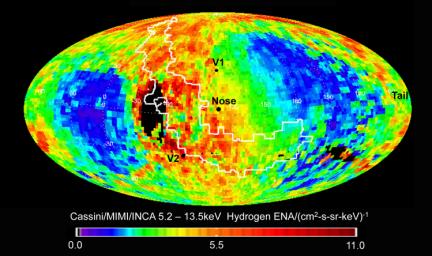Data from NASA's Cassini spacecraft have enabled scientists to create this map of the heliosphere, the bubble of charged particles around our sun.
Charged particles stream out from our sun in a phenomenon known as solar wind. The solar wind interacts with the matter between stars, which is known as the interstellar medium. The mingling of interstellar medium and solar wind creates particles called energetic neutral atoms, which stream back towards the sun.
The ion and neutral camera on Cassini's magnetospheric imaging instrument detects energetic neutral atoms. This map shows those in the range of 5,200 to 13,500 electron volts. The regions with the highest intensity of particles are red and those with the lowest intensity of particles are blue.
Cassini detects a different spectrum of energetic neutral atoms than NASA's Interstellar Boundary Explorer (IBEX) does. The IBEX images show lower-energy particles. NASA's Voyager mission collects data on energetic ions in the region that is the source of the energetic neutral atoms.
The area where IBEX found a ribbon of high-intensity particles is outlined in white. The locations of Voyager 1 and Voyager 2 are indicated with the labels "V1" and "V2." The label "nose" indicates the direction that our solar system is traveling through the interstellar medium. The label "tail" indicates the region in the direction opposite the nose.
The Cassini-Huygens mission is a cooperative project of NASA, the European Space Agency and the Italian Space Agency. NASA's Jet Propulsion Laboratory, a division of the California Institute of Technology in Pasadena, Calif. manages the mission for NASA's Science Mission Directorate, Washington, D.C. The Cassini orbiter was designed, developed and assembled at JPL. The magnetospheric imaging team is based at the Johns Hopkins University Applied Physics Laboratory, Laurel, Md.
The Voyagers were also built by JPL, which continues to operate both spacecraft.
For more information about the Cassini-Huygens mission visit http://saturn.jpl.nasa.gov and http://www.nasa.gov/cassini.
For more information about the Voyager spacecraft, visit http://www.nasa.gov/voyager and http://voyager.jpl.nasa.gov.

 Planetary Data System
Planetary Data System












